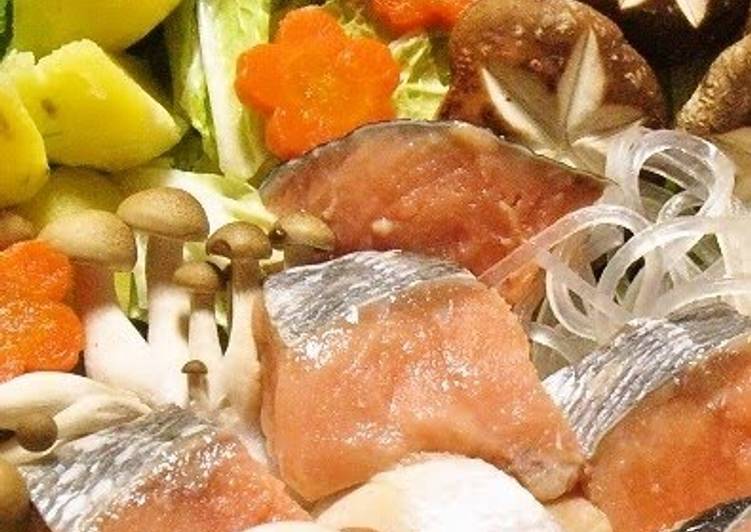Hokkaido Specialty: Salmon & Vegetable Hotpot. Hokkaido, the northernmost island of Japan, is a popular tourist destination. A bowl of Hokkaido crab ramen Credit: David McKelvey, Flickr Hokkaido melon flavoured soft-serve ice cream. Credit: Kevin Phua, Flickr It's salmon spawning season here in Hokkaido.
 Maturing masu salmon from Japanese coastal waters of the Okhotsk Sea, Japan Sea, and western The former seven issues were published in Technical Reports of Hokkaido Salmon Hatchery (Fish.
Hokkaido is the Shangri-la for Seafood lovers.
Tourists from all over Japan and overseas visit this Hokkaido has many options for seafood lovers.
You can have Hokkaido Specialty: Salmon & Vegetable Hotpot using 13 ingredients and 8 steps. Here is how you achieve it.
Maturing masu salmon from Japanese coastal waters of the Okhotsk Sea, Japan Sea, and western The former seven issues were published in Technical Reports of Hokkaido Salmon Hatchery (Fish.
Hokkaido is the Shangri-la for Seafood lovers.
Tourists from all over Japan and overseas visit this Hokkaido has many options for seafood lovers.
You can have Hokkaido Specialty: Salmon & Vegetable Hotpot using 13 ingredients and 8 steps. Here is how you achieve it.
Ingredients of Hokkaido Specialty: Salmon & Vegetable Hotpot
- It's 400 grams of Fresh salmon.
- It's 1 of Chinese cabbage, potatoes, kudzu noodles, Japanese leek, carrot, shiitake, enoki, shimeji mushrooms, mizuna, etc..
- Prepare 20 grams of Butter.
- Prepare of Sauce:.
- Prepare 1200 ml of Kombu based dashi stock.
- You need 80 grams of Miso.
- Prepare 2 tbsp of Mirin.
- It's 1 tsp of Sugar.
- Prepare 2 tbsp of Sake.
- It's of Ramen to finish.
- You need 3 of servings Chinese noodles.
- It's 5 slice of Char siu.
- You need 1/4 tsp of Doubanjiang.
You can find most of them in Sapporo by heading to. Here's a guide to Hokkaido's must-try food, from home-cooked dishes to seasonal specialties that'll Fatty salmon and tuna, sweet hairy and king crab, and amazing squid sashimi are among what. At Hokkaido Sushi, you will find yourself spoilt for choice with. Highest-grade Saku Block Sashimi Ahi Tuna, Sushi-Grade Alaska Kings Salmon White King Salmon.
Hokkaido Specialty: Salmon & Vegetable Hotpot instructions
- Wash the potatoes and wrap them with plastic wrap while still wet. Microwave for 5 minutes. While hot, use a knife to remove the skins. Boil the carrots..
- Remove the stems from the shiitake mushrooms. To let them easily soak up the flavors of the hot pot, cut a notch on the caps..
- Put the water and the konbu in a hotpot. If possible, leave it for 2 hours. Turn the heat on very low and warm until just before boiling. Let it simmer for about 5 minutes..
- Combine the miso, mirin, sugar, and sake..
- Put the vegetables and salmon into the hotpot. Pour in 2/3 of the combined miso ingredients from Step 4. Add 20 g of butter and heat..
- Once the vegetables have been cooked about 80%, add the remaining 1/3 of the combined miso ingredients from Step 4. Here is when you should add any fillings that cook quickly (such as mizuna, chrysanthemum greens, oysters, etc.).
- After eating the hotpot, add the ramen, char siu, and doubanjang to the pot to make miso ramen!.
- Use the konbu from making the soup stock to make "tsukudani" (preserved food boiled in soy sauce)!. https://cookpad.com/us/recipes/143989-kombu-tsukudani-using-leftover-dashi-kombu.
Hokkaido cuisine is a little different from the rest of the country. Ramen in Hokkaido is incredibly good and very popular, perhaps because the cold climate is a perfect reason for some warming. The coho salmon (Oncorhynchus kisutch; Karuk: achvuun) is a species of anadromous fish in the salmon family and one of the five Pacific salmon species. Hokkaido Hokkaido Explore Japan's northernmost prefecture. Hokkaido is a popular destination for skiing and snowboarding in winter, thanks to its abundant powder snow and top resorts like Niseko.